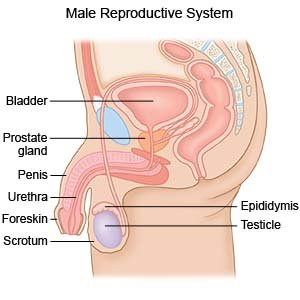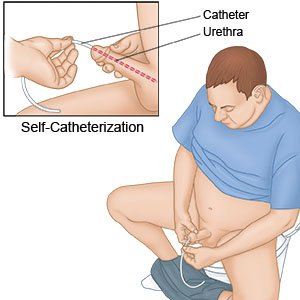Cryosurgery for Prostate Cancer
Medically reviewed by Drugs.com. Last updated on Apr 6, 2025.
Cryosurgery, also called cryotherapy or cryoablation, is surgery to treat prostate cancer by freezing the prostate cancer cells. The prostate is a male sex gland that helps make semen.
 |
DISCHARGE INSTRUCTIONS:
Call your local emergency number (911 in the US) if:
- You suddenly feel lightheaded and short of breath.
- You have chest pain when you take a deep breath or cough.
- You cough up blood.
Seek care immediately if:
- Your arm or leg feels warm, tender, and painful. It may look swollen and red.
- You cannot urinate, or if you have a catheter, no urine is filling the bag.
- You have a blocked catheter or a problem with your catheter.
- You have redness, pain, blood, or drainage where the catheter enters your penis.
- Your urine smells bad or becomes red and cloudy.
Call your doctor or surgeon if:
- You have a fever.
- You have pain that does not decrease or go away after you take your medicine.
- Your urine looks pink, or you have trouble urinating.
- You have chills, a cough, or feel weak and achy.
- You are dizzy, nauseated, or vomiting.
- You have questions or concerns about your condition or care.
Medicines:
- Prescription pain medicine may be given. Ask your healthcare provider how to take this medicine safely. Some prescription pain medicines contain acetaminophen. Do not take other medicines that contain acetaminophen without talking to your healthcare provider. Too much acetaminophen may cause liver damage. Prescription pain medicine may cause constipation. Ask your healthcare provider how to prevent or treat constipation.
- Take your medicine as directed. Contact your healthcare provider if you think your medicine is not helping or if you have side effects. Tell your provider if you are allergic to any medicine. Keep a list of the medicines, vitamins, and herbs you take. Include the amounts, and when and why you take them. Bring the list or the pill bottles to follow-up visits. Carry your medicine list with you in case of an emergency.
Drugs used to treat this and similar conditions
Sandostatin
Sandostatin is used to treat acromegaly and to reduce flushing episodes and watery diarrhea caused ...
Sandostatin LAR Depot
Sandostatin LAR Depot is used for acromegaly, carcinoid tumor, vasoactive intestinal peptide tumor
Omvoh
Omvoh is used to treat moderate to severe ulcerative colitis or Crohn's disease in adults. This ...
Lupron Depot
Lupron Depot (leuprolide acetate) and Lupron Depot-Ped are prescription hormonal injections used to ...
Casodex
Casodex (bicalutamide) is an anti-androgen and is used together with LHRH to treat prostate cancer ...
Xtandi
Xtandi (enzalutamide) is an anti-androgen used to treat prostate prostate cancer. Includes Xtandi ...
Zytiga
Zytiga (abiraterone) is used together with prednisone to treat prostate cancer that has spread to ...
Eligard
Eligard (leuprolide) reduces levels of testosterone and is used to treat prostate cancer. Includes ...
Octreotide
Octreotide systemic is used for acromegaly, carcinoid tumor, diabetes, type 1, diarrhea, dumping ...
Abiraterone
Abiraterone is used along with prednisone or methylprednisolone to treat prostate cancer. Includes ...
Do pelvic floor exercises as directed:
The exercises squeeze your pelvic floor muscles and help them become stronger. To do pelvic floor exercises, squeeze your muscles like you want to stop urinating. Hold for 3 seconds and then relax. Ask your healthcare provider when to start doing these exercises, and how often to do them.
Care for the surgery area:
When you are allowed to bathe or shower, carefully wash the area with soap and water. Dry the area and put on new, clean bandages as directed. Change your bandages when they get wet or dirty.
Bladder care:
- Drink liquids as directed. Ask how much liquid to drink each day and which liquids are best for you. Liquids will help flush your bladder and prevent infection.
- You may need to learn how to replace a catheter. A catheter is a soft rubber tube that you put into your urethra to drain your urine. Ask your healthcare provider for more information on self-catheterization and catheter care.

- Do not let your bladder become too full before you empty it. Set regular times each day to urinate. Urinate as soon as you feel the need. Try to urinate every 3 hours while you are awake. Do not drink liquids right before you go to bed. At bedtime, urinate before you lie down. This will keep you from having to get up to urinate after you go to bed.
Sexual activity:
Ask when you can start to have sex again. After cryosurgery, you may have problems such as trouble having an erection. This is called erectile dysfunction (ED). These problems may not last long and most can be helped. Talk to your healthcare provider if you have concerns about ED.
Do not smoke:
Nicotine and other chemicals in cigarettes and cigars can cause lung damage and increase your risk for new or returning cancer. Ask your healthcare provider for information if you currently smoke and need help to quit. E-cigarettes or smokeless tobacco still contain nicotine. Talk to your healthcare provider before you use these products.
Follow up with your doctor or surgeon as directed:
Ask when to return to have your wound checked, catheter taken out, or stitches removed. Ask if you need to have radiation therapy and when you need to return for the treatment. Write down your questions so you remember to ask them during your visits.
© Copyright Merative 2025 Information is for End User's use only and may not be sold, redistributed or otherwise used for commercial purposes.
The above information is an educational aid only. It is not intended as medical advice for individual conditions or treatments. Talk to your doctor, nurse or pharmacist before following any medical regimen to see if it is safe and effective for you.
Learn more about Cryosurgery for Prostate Cancer
Care guides
Further information
Always consult your healthcare provider to ensure the information displayed on this page applies to your personal circumstances.
